Ever spent a lot of time on link prospecting but ended up with miserable results? You’re not alone.
The whole process seems straightforward. Take a backlink checker, download websites linking to content and product like yours, and voila! Your list of link building prospects is ready.
No rocket science.
But the problem is everyone who promotes their business via blogger outreach and link building follows the same blueprint.
The outcome? The same people receive tons of similar link requests.
Once the threshold of around 50 emails is crossed (the number depends on each blogger’s emotional stability), many of them start ignoring all the upcoming messages on the same subject, including yours.
While the reality is becoming harsh on the link building arena, it’s still too early to give up.
Learn how to do link prospecting in a way to face less competition.
P.S. For convenience, I divided the guide based on the type of blogger outreach targets.
Bloggers who link to content on your target topic
A short foreword. Bloggers who link to posts on your target topic, aka your competing pages, should go first on your list.
If they are fine with linking to a similar post, you have a fair chance of having that link replaced with yours.
Note that this contextual targeting will work only if your content is ten times better than someone else’s.
To find such link prospects, check pages ranking for keywords related to your target topic in Google.
Let’s say you’ve published a compilation of keyword tools.
Google a query like “best keyword tools” and switch to the top 100 results via settings.

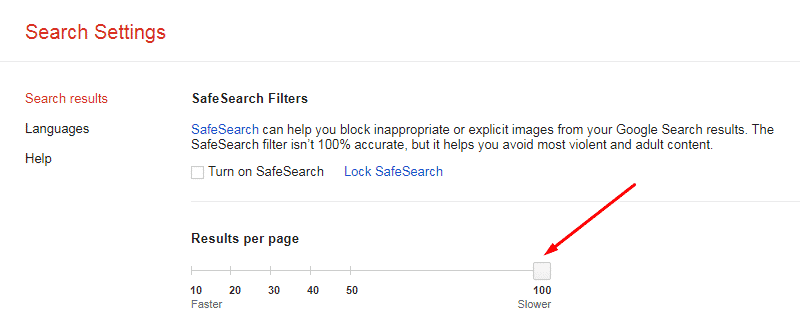
Using a free web scraper, copy URLs of those pages and paste them into Google Sheets or Excel.

Next, see who links to each URL on your list with a backlink checker. This one shows 100 backlinks to a page for free. To see all of them, you’ll need to go premium.

What most folks do. Many people limit themselves here.
They check link prospects for a very basic query (“keyword tools” in our case) and probably a few variations (“best keyword tools,” “free keyword tools,” “keyword tools 2020,” etc).
While there’s nothing wrong with such a tactic, that’s what everyone does. Authors of articles ranking for those basic queries are bombarded with link requests like yours.
You’ll have to face tougher competition.
What you should do. Try to diversify the way you phrase your queries. It’ll help you decrease the level of competition at this stage.
Learn which keywords pages ranking for your basic query also rank for. For example, Ahrefs Keywords Explorer has a standalone report for this.

As shown above, pages ranking for “keyword tools” also rank for alternatives to Google Keyword Planner, Semrush, and other well-known tools.
Check out who links to pages ranking for those queries. Not only are they relevant for you, but also easier to approach due to fewer link requests they receive.
If you don’t have a tool at hand, you can use your logic.
In our example, keyword tools help users find people’s search queries. If you follow the logic, keywords are equivalent to topics to write about.
So, your link prospects could be bloggers linking to compilations of blog topic generators or, say, content idea generators.
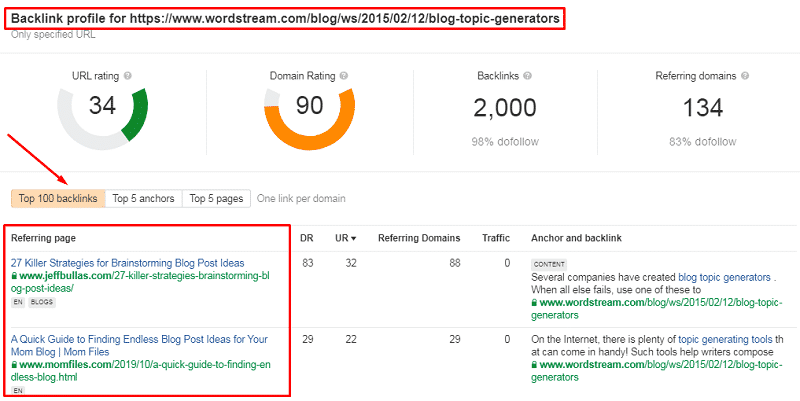
In your email, tell bloggers that your tools let users find topic ideas with search traffic potential, not just those that sound good.
Most likely, their readers will find them more helpful, especially if they’re interested in driving more traffic to their blogs. And who isn’t? 🙂
Bloggers who’ve published content on your target topic
A short foreword. You and bloggers who cover your topics are pretty much on the same page.
They are interested in the same stuff you are and should be curious to check out any related content.
Finding like-minded link prospects in Google is a moment’s work.
If you followed the previous step, you should already have them. I’m referring to pages that rank for your target keywords in Google, those you extracted via a web scraper.
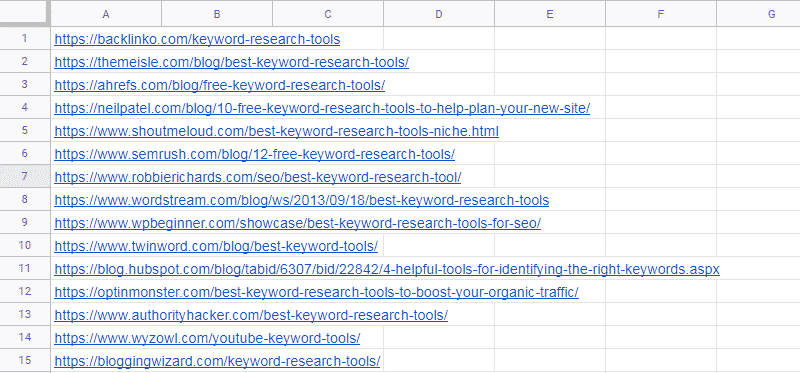
What most folks do. Many writers ask bloggers to check out their similar articles and never hear back from them.
No wonder.
While common interests can attract the attention of your topic allies, similar content can’t.
When you reach out to authors of posts on your topic, you’re trying to deal with your content competitors.
Not all of them will be responsive, especially if you don’t give them a compelling reason to be.
What you should do. You should approach such link prospects delicately and only if your content permits.
Find out what’s missing in a competing post and make sure yours can fill the gap.
Then, reach out and explain why your data could be a useful addition to the info already published.
For example, almost no one makes a feature comparison. Hell yeah, it requires a huge investment of time to test each tool and gain such insights.
But don’t regret spending time on unique content. Regret spending time on outreach that will bring you little to no backlinks.
If you compare features of tools, you can offer bloggers to embed your comparison table with link attribution to your original.
Their readers will appreciate such a convenient way to compare items on their list.
Note. Reach out to this category of link prospects only if you compete with them on the topic. If they are your direct competitors on the product, better stay away.
A short foreword. At this stage of link prospecting, you should google articles where your content will fit in.
Let’s stick to our example of building links to a compilation of keyword tools. In this case, your link prospects are authors of keyword research guides.
What kind of keyword research can go without tools and their metrics?
The question is rhetorical 🙂
What most folks do. Just like in the first section, people stop too early here.
They usually don’t go any further than running a search for obvious queries like “keyword research guide,” “how to find keywords,” etc.
What you should do. To expand your list of link prospects, you should be more ingenious.
Try to brainstorm ideas of how your content could be helpful in more specific terms.
The easiest way in our case is to enter a landing page of any tool and check what purposes its features serve.
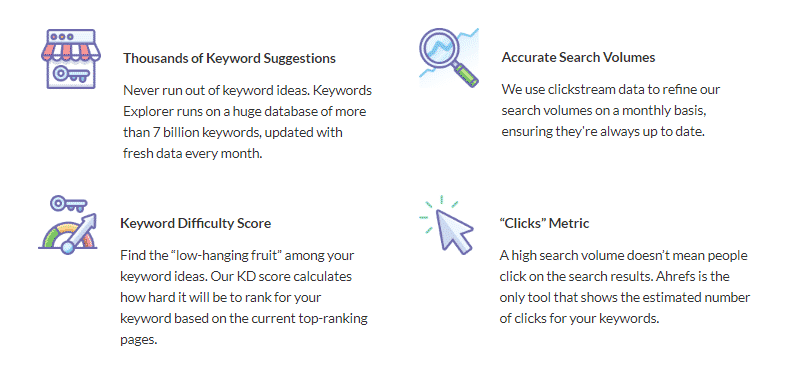
| Features | Possible search queries to target |
|---|---|
| Thousands of Keyword Suggestions | queries related to content ideation: how to find topic ideas, how to overcome writer’s block, etc |
| Keyword Difficulty Score | queries related to rankings: how to rank in the top, how to grow search rankings, etc |
| Search Volumes / Clicks | queries related to traffic: how to increase website traffic, how to get more visitors to your website, etc |
In fact, you can expand each topic with even more specific subtopics.
For example, enter a query like “blog ideas” in your go-to tool and check long-tail keywords for it.
Your link prospecting list will include posts about blog ideas for different niches, e.g. lifestyle, travel, real estate, etc.

Speaking about queries related to traffic, you can find link prospects for different types of sites (online stores, blogs) and platforms (Shopify, WordPress).
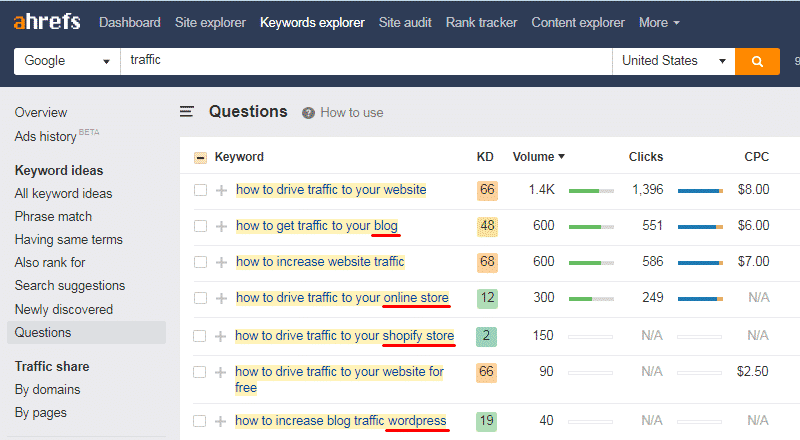
Bloggers who link to your competitors
A short foreword. Competitors’ backlink profiles are sources of information on any question:
- which of competitors’ backlinks can bring them referral traffic;
- what kind of content works best in terms of link building in your niche;
- if they participate in interviews and podcasts;
- if they record webinars with tools like Zoom to teach their audiences;
- who links to them on an ongoing basis;
- where they submit guest posts.
If your competitors are welcome in those places, you should be too.
What most folks do. Analyzing competitors’ backlink profiles, many people try to imitate them way too close.
They consider all of their competitors’ referring domains to be their link prospects.
For example, if someone’s case study has many backlinks, people research the same topic and end up with similar findings.
But do link prospects need another study that proves what they already know?
Another common failure is when people see competitors’ backlinks from testimonials, they start offering their feedback too.
But unless they are big names in their niche, there’s hardly anyone who’d be interested in testimonials from them.
What you should do. There’s no need to replicate every backlink of your competitor.
Instead, focus on backlinks strategically important for your business exposure.
First of all, these are compilations of products like yours that don’t link to you.
If your product is a keyword tool, run a search for “best keyword tools” and click through results to see where you aren’t on the list.
Next, ask bloggers who ignored you to check out your tool and give it a spin if they find it worthy.
To sound persuasive, you can analyze competitors’ pricing and reach out under the excuse that your tool is more affordable than many others listed. That way, it will be a better option for startups and everyone else who sticks to a tight budget.
Make sure you provide free access for them if your product isn’t free.
Compilations with monthly organic traffic are more valuable link prospects in this case.
Besides backlinks, you’ll get website visitors who can convert into paid users eventually.
Bloggers who accept guest posts (for free, of course)
A short foreword. Guest blogs are basically the only link prospects that give you some control over the anchor text.
Does your backlink profile contain mostly branded and URL anchors? Then, do some guest posting to mix them with keyword anchors.
What most folks do. Many guest post seekers use the same search strings to find guest blogs:
keyword “write for us”
keyword “submit content”
keyword “guest post by”
And the list goes on.
The truth is blogs that have “write for us” pages receive multiple pitches daily.
Some of them have become so picky that they discard good pitches.
Others have come up with a more creative way of selection. They welcome only writers who won’t mind paying them a “small publishing fee,” which is nonsense if your content is good.
What you should do. Take a look at guest blogging from a content angle – it’s not all about link building.
If you offer bloggers high-quality content for free, it’s in their best interest to publish it.
To accept your pitch, bloggers don’t necessarily have to have a “write for us” page. Neither should they mark some of their articles as “guest posts.”
And they do have a point.
Especially since Matt Cutts from Google said any backlink manipulations via guest blogging are forbidden.
The bottom line?
To find blogs potentially interested in your topic, google it without any search strings.

Next, check out if your target blog accepts guest contributions. Head to an author’s bio to see if that person is an in-house writer or from an outside company.
Let’s enter the first blog in the top 10 and click through its articles.
Many of them are written by Buffer’s staff, except for this one. Its author is Anum Hussain from a different company Acciyo.

There’s not a single mention on the page that it’s a guest post, but it still is!
So, Buffer does accept guest posts, regardless of the fact that they don’t have a “write for us’ page.
Also, install a free extension from Moz to make sure outgoing links in a guest post are dofollow.

Bloggers who link to dead pages
A short foreword. Known as broken link building, this strategy is about helping both parties.
You’ll earn new backlinks, while your link prospects will fix broken link issues on their domains.
Use a broken backlink checker to find competitors’ dead pages that still have live backlinks.
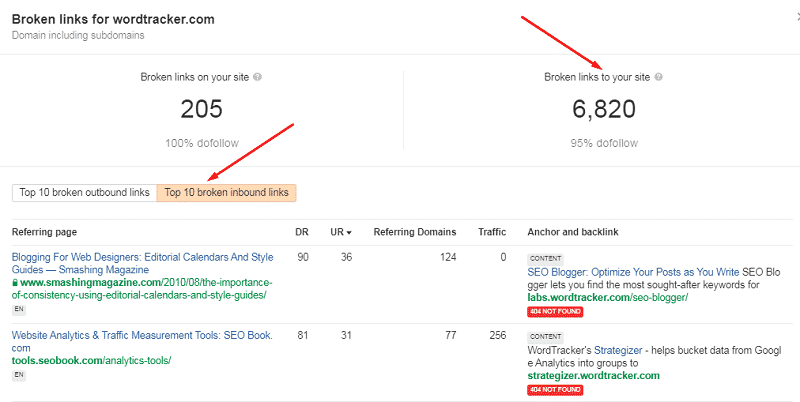
What most folks do. Dead pages exist not only on live domains. And that’s what many people overlook in broken link building.
Over time, some companies grow into seven-figure businesses, while others go broke and shut down. Naturally, their domains with many content pages get expired. In this case, it's a good idea to use a domain scanner and check for any existing issues.
Bloggers don’t keep an eye on every company they’ve ever mentioned. So, live backlinks to expired domains are still on their blogs.
What you should do. Find expired domains related to your business using this free service.
Type in your target keyword and sort results by backlinks (BL) to check the most linked-to expired domains.

Note that expired domains relevant to your business won’t always include your target keyword in their names.
And expireddomains.net shows only domains you can buy, but many of them aren’t on sale.
As a plan B, you can search for articles published years ago and check if they feature any discontinued items.
Let’s search for “free keyword tools” with a date range of 2010-2015.
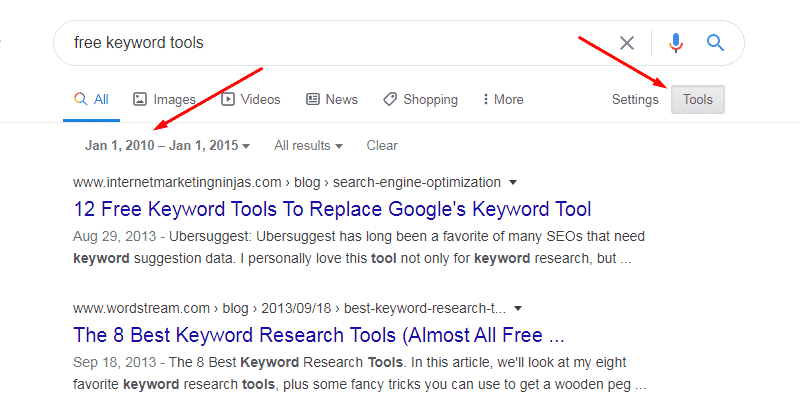
The first article suggested links to a discontinued tool that used to be hosted on wordpot.com.

Now, let’s inspect the backlink profile of wordpot.com. Although it’s been discontinued for a while, it still has backlinks from 363 referring domains. 72% of them link to it via dofollow links.

Bloggers who mentioned you but never linked to your site
A short foreword. There are cases when you’re much closer to gaining backlinks than you think.
These are sites with unlinked mentions of your business. By default, they’ll give you privilege over others who will reach out to owners of those blogs.
You are not a complete stranger to those bloggers. They should have a good impression of your business if they decided to give it a mention.
Half the job is already done for you.
To find unlinked mentions, you can use Google and a bunch of advanced search operators:
intext:
Use this operator to find pages containing your business name.
– (a minus sign)
This operator will help you exclude pages from domains you don’t need to check. These can be your site or sites, guest blogs you contribute to, or any other sites that make no sense for link building like social networks.
Since Google won’t show you all the results found, make sure to exclude as many unnecessary domains as possible.
For example, there are 11,900 results for OutreachMama, social networks excluded.

But you’ll be able to check only 196 results.

If you include omitted results, the number will grow to 319, but that’s still not even a thousand.

Is it a dead end? No, you can filter results by different date ranges to extract more URLs, e.g. first for 2020, next for 2019, and so on.

What most folks do. Many hunters for unlinked mentions check their company or domain names only and call it a day.
But that way, a lot of other business mentions drop off their radars.
What you should do. Expand your list with more possible mentions related to your business. Here they are.
Branded product names
If you give unique names to your products, check them for unlinked mentions.
For example, Apple’s branded product names are iPad, iPhone, Mac, Safari, iTunes, etc.
The U.S. developer of website templates, TemplateMonster, brands their products with creative names too – Woostroid, Apparelix, etc. You got the idea.

Mentions of team members
When quoting someone, bloggers usually refer to the company’s representatives rather than the company as a whole.
That’s why you should google mentions of your team members to see if they’re all linked to your site.

Stolen visuals without link attribution
The reason why people steal content is a mystery [sarcasm]. But the fact is they do, and visual content isn’t an exception here.
Do a reverse image search to check if someone has re-posted your pics and forgot to link to the original.
Right-click on your target image and then left-click on “Search Google for image.”

You can perform a search for any visuals, including custom featured images, research graphs and charts, infographics, logos, flyers, etc. Utilize a flyer maker to easily create eye-catching promotional materials for your needs.
This one is a favorite tactic for many blog outreach companies because its easy to find prospects and straightforward for landing links.
Links to social media profiles
At times, bloggers link to companies’ social media posts and profiles instead of their websites directly.
Such links do give some exposure, but they are absolutely useless for growing website authority and search rankings along the way.
You can find such wasted link opportunities with a backlink checker you have at hand.
Enter URLs of your company’s social media profiles and team members.

For example, guys from Tribute Media link to OutreachMama’s Twitter profile via a dofollow backlink. But there’s no outreachmama.com among the domains tributemedia.com links to.

Since tributemedia.com has a high DR of 72, it makes sense to redirect the currently wasted link juice to outreachmama.com.
Misspelled backlinks
Lack of attention is quite common among bloggers, and some of them misspell domain names when linking out.
While such incorrectly linked mentions are legally yours, link juice they send still doesn’t reach its destination.
To find misspelled backlinks, generate possible typos of your domain name via this free tool.
Next, use your backlink checker to see if any of those misspelled domains have backlinks.
For example, fromthedogspaw.com links to outreachmOma.com instead of its correct version outreachmAma.com via a dofollow backlink.
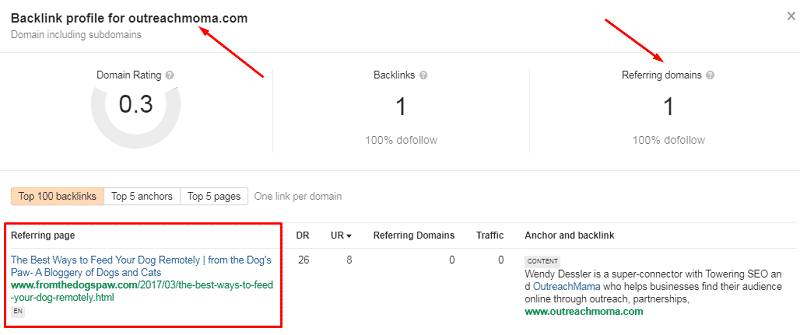
Bloggers you link out to from your site and guest posts
A short foreword. In SEO circles, there’s a rule to link out from every post to at least 3-4 relevant websites with high authority.
Such outbound links serve as trust signals and prove content relevance to search queries Google will rank it for.
In terms of link prospecting, you can use this scheme for your own good.
Each time you link out to bloggers, notify them about how useful their content turned out for yours that you referred to it.
They will be thankful for such a nice gesture.
Some prospects will link to you in return. Others will at least share your write-up with their social followers who can link to you in their turn.
What most folks do. When writers need to link out somewhere, they randomly pick one of the first pages they see in Google search.
But the thing is another backlink won’t do much good to those top-ranking pages.
Think about it. They already have what they want and got it without your help. You won’t do them a big favor with another backlink, you see.
What you should do. You should help the needy rather than well-off folks.
Instead of linking out to posts that already feel good in the top 10, better target pages lagging behind. Look for them on the 2nd or 3rd pages of search results.
Your backlink will help them get closer to the top, where most traffic comes from.
Underperformers will appreciate your link much more than those in the top 10.
That way, they’ll be more willing to cooperate with you and pay you back with a backlink eventually.
Note. I’m not saying you should pick some untrustworthy domain with a zero or close-to-zero DR.
Google does dictate that we should link out to authority sites only. But such sites don’t necessarily rank for all the keywords they target in the top 10.
You’ll find a lot of credible domains with a medium-to-high DR on the 2nd and 3rd pages of Google search.
Check out what kind of pages ranking below the top 10 results you should target.
Pages that drive less traffic
Let’s say you want to link out to a compilation of the best keyword research tools.
Currently, pages ranking in the top 10 generate hundreds to thousands of monthly visitors from organic search. You can figure it out with a SERP checker like this.

To compare, many pages ranking in the top 11-20 don’t get even a hundred visits per month.
Help one of them rise above in SERP to get more traffic with your backlink.

Pages that have fewer referring domains
If a page has backlinks from 297 referring domains like #11 result, you won’t impress its author with your 298th.
With a ratio of 1 / 298, you understand how miserable the value you provide is, don’t you?
Instead, target pages with fewer backlinks like #12, #13 or even #15 with no referring domains. Your contribution will look more valuable in the eyes of such link prospects.

Are you curious why I estimated referring domains instead of backlinks? Here’s a short foreword about how the unspoken formula of link juice efficiency works.
It makes more sense to get 10 backlinks from 10 domains rather than from the same domain. That way, you’ll receive link juice from 10 domains, not just one.
Pages of strategic importance to businesses
Today, almost no one agrees to link out to promotional content they are not affiliated with.
Editors get so frustrated with links to product pages in guest posts that they remove them before even reading the first sentence.
That’s why building links to such content is a challenge.
Instead of linking out to any random stuff on your target domain, focus on pages strategically relevant to their business.
Here they are:
- product pages;
- news about product releases or updates;
- guides to doing things with the help of their products;
- compilations of their products;
- blog posts that have affiliate links.
Let’s check out the page ranking #13 from the screenshot above. It has many affiliate links that you can recognize by the following URL pattern:
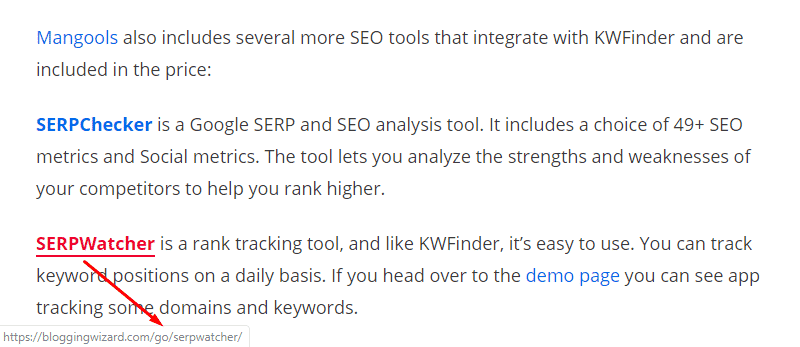
Imagine how thankful bloggers will be for your backlink if it moves their post up, bringing them more visitors and affiliate sales.
Final Word
Following this guide, you should find bloggers who will be more responsive to your emails.
Note that link prospecting tactics that most folks use don’t always fail.
With a solid product (or content) and some luck, you’ll be able to find a bunch of cool link prospects that way.
But you’ll also have to beat off more competitors there, which will result in lower response rates of your link requests.
And the goal of this guide is to bring you to places with easier backlink wins.




























